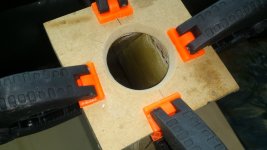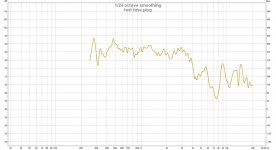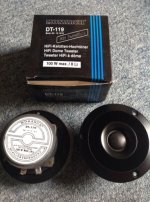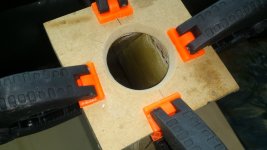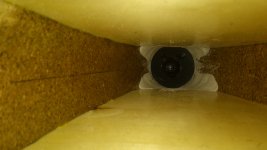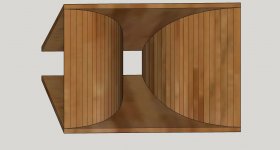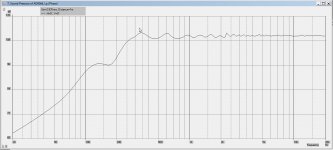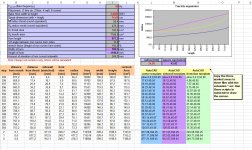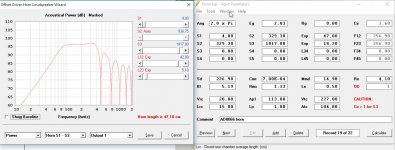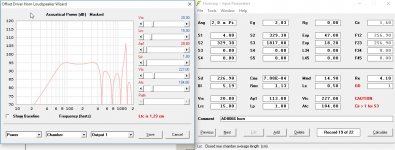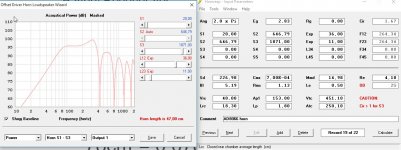If you don't mind a 3-way design the adding a K tube tweeter like this can work well. It will certainly give more detailed HF output. The physical alignment is excellent and for all intents and purposes remains a summation point source horn.
I think a compression driver on the K tube is overkill and they have higher HD. A 1in dome tweeter with a low distortion motor and damped rear chamber will work nicely. Even a cheap DC28F-8 would be excellent.
Thanks, you're great and design and construct at the speed of sound !
I don't need K tweeter, it was an idea, just that, seing the passive of Kees (I like also the idea of passive and don't give up the idea myself but the fact I want to learn FIR phase and active for the pleasure of my prefered hobby)! I like so much your idea of 5000/800 Hz XO for F10 in a horn ! and Imho due to my slowness and the challenge of mid-bass for me (2 x B&C CL51 planned... cost avaibility being good here for those drivers)... I have enough work for one year (wait for the last amp of Dr M as well 😀 !)
Mking a tangarine faseplug for a normal cone is not easy, it works but you get a lot of IM.
pointy faseplugs with rings however do work to get less peaks and such and extention.
Last picture is with arta and a K-tube tweeter, it go way more loud then a high pass correction.
second picture you see the cone can not keep up with compression, I think a horn in a horn in a horn
is bet best way, but for 80 Hz it is litlle bigger, why I think this is when have the full efficienty of
a horn give the most transparent, detailed and fast sound.
I gp put a K-tube in, maybe some deeper in throat getting fase equal.
see picturs.
kees
pointy faseplugs with rings however do work to get less peaks and such and extention.
Last picture is with arta and a K-tube tweeter, it go way more loud then a high pass correction.
second picture you see the cone can not keep up with compression, I think a horn in a horn in a horn
is bet best way, but for 80 Hz it is litlle bigger, why I think this is when have the full efficienty of
a horn give the most transparent, detailed and fast sound.
I gp put a K-tube in, maybe some deeper in throat getting fase equal.
see picturs.
kees
Attachments
Last edited:
I like the results of the K-tube! With correct location you can get a spot on phase match. I might have to try this. What are you using to drive K tube?
I like the results of the K-tube! With correct location you can get a spot on phase match. I might have to try this. What are you using to drive K tube?
Hi X
I am a little late busy and reading, special with the build of the welding inverter, it do well.
I did see on other threat that a surround damping do work well? just mill some material away under the speaker surround and make a damping ring to fill up again, so it seems the surround is a trouble maker with the dips and cancelations. this is why we need cloth surround speakers for horn and not rubber.'You did make a adaptor and make it round, looks a little as I did to make it round, I go make one with karpet vilt ring.
For the K tube, when ik put it deeper in throat and use a 1 inch it work nice I think, and when the voicecoil is in line with the full range it is also in fase, but we can move a lot so find a other fase spot.
I did use a double magnet monarch dt119 a old one with high sensitivity.
I did think of make a horn with a speaker 8 inch and go from 90 hz to 2 khz and further to a K-tube with compression driver making a high sensitive horn but bigger it is but no need of side woofers.
regards
Attachments
Last edited:
Where i read, they say 3 octaves is what a horn should only do. More, the sound gets muddy.
In my horn, i lowered the crossover point to my hanging-in-mouth tweeter from 2650 to 2450 Hz and this small change was very noticeable, the sound opened and sounds cleaner. The problem is that at high volume the tweeter is not coping very well with this low xo point..
In my horn, i lowered the crossover point to my hanging-in-mouth tweeter from 2650 to 2450 Hz and this small change was very noticeable, the sound opened and sounds cleaner. The problem is that at high volume the tweeter is not coping very well with this low xo point..
Where i read, they say 3 octaves is what a horn should only do. More, the sound gets muddy.
In my horn, i lowered the crossover point to my hanging-in-mouth tweeter from 2650 to 2450 Hz and this small change was very noticeable, the sound opened and sounds cleaner. The problem is that at high volume the tweeter is not coping very well with this low xo point..
Maybe that is why I want to try with a K tube tweeter, I did and it sound quite good measuring is less good, but have a really noisy house..
The most problems occur whit path length differences, therefore a phaseplug is used, however when cancel this on hf we need more compression and so hars sound when not done right.
For a cone speaker a compression plug is not a good idea I did discover, the cone is to weak and also the motor, therefore a good compression driver has a big magnet.
regards
Last edited:
Room is very very important. A few days ago i sat down near and between speakers. The sound and stage was impressive. All clear and no distortion. I listened Malmsteen's Inspiration album. It was like i was in the front row! No reflections is very good..
I am go try a tractrix for 80 a 90 hz and a K tube driver.
I am struglle a little with calculation of the horn, when in corner it is a lot smaller, and against a wall it is some bigger but handle it is oke, free air and I get a big one.
Now is a free air horn most used on a pa system outside, so I think someone here can advise me what to make, I did thought about a wall horn, if these can also work in a corner, or just a corner because most speakers are in a corner of a home.
regards and thanks.
I am struglle a little with calculation of the horn, when in corner it is a lot smaller, and against a wall it is some bigger but handle it is oke, free air and I get a big one.
Now is a free air horn most used on a pa system outside, so I think someone here can advise me what to make, I did thought about a wall horn, if these can also work in a corner, or just a corner because most speakers are in a corner of a home.
regards and thanks.
Just take the current plans for 180Hz and scale by 2x. Then it is 90Hz horn. Throat will be 5.5in so you can use an 7in to 8in driver.
Just take the current plans for 180Hz and scale by 2x. Then it is 90Hz horn. Throat will be 5.5in so you can use an 7in to 8in driver.
mouth is smaller with my new drawn 10 x 10 cm so that surround is not seen for a 8 incher, I want to do like you did, a rounded plate with damping ring under the surround blocking resonances, but maybe for this it is not needed, the phillips I go use for it, only I have to change akabak script removing everything what is not needed.
I have drawn a wall horn, so it is not to big, a corner type is even smaller.
I have now 50 cm deep, 49 wide 73 high fitting nicely in a corner 80 hz .
this I try to get as wide as the 8 inch do without distortion and that is 3 Khz, and there a compression driver with a K-tube take over, and sub bas with a tapped horn, so I have a sensitive system for tube amps use and not that big.
I go however do make the ring also for the present horn, curiousity is the reason.
And first scan my pc, it do strange gehavior, thing go do from thereselfs without me, and opens, very unstable, so scan for virus now.
regards
kees
Attachments
X
I have done a sim for a 80 hz horn but akabak say it go down on 250 hz, maybe it do not take in account the placing on the wall as 4 pi.
do I have then make a free space horn? then it go bigger.
Also the hf is not real, this is a woofer who stops on 4 Khz, so I need to implement a chamber in akabak.
regards
I have done a sim for a 80 hz horn but akabak say it go down on 250 hz, maybe it do not take in account the placing on the wall as 4 pi.
do I have then make a free space horn? then it go bigger.
Also the hf is not real, this is a woofer who stops on 4 Khz, so I need to implement a chamber in akabak.
regards
Attachments
You can turn on wall boundaries. It's in the script already may just be turned off. All the reflection switches in radiator elements need to be on. Then there is the main wall reflection term that specifies how far floor and wall are away.
You can turn on wall boundaries. It's in the script already may just be turned off. All the reflection switches in radiator elements need to be on. Then there is the main wall reflection term that specifies how far floor and wall are away.
Here is a zip, if you want to do a quick look if I have done it right, thanks. Included is volvotreter calc and script.
I have managed to get better plot but not quite compleet oke, I think a corner horn who is not that big is nice for with a K-tube and a tapped horn, then I need a compression driver for high..
Reflection switches? I did see reflection there but not seen a OFF.
regards
Attachments
Last edited:
Just a idea, I want to make the horn not square but smaller on the conic side, so I can make the horn bigger and it,s wide smaller, how far can I go with that? I have made the ratio now 2,00 in calculator making it fit right in the house, high is no problem width is.
see the picture, these are quite nice.
the other picture is how I go to make it, with strong birch (picture is not from me but get it from the internet.)
regards
see the picture, these are quite nice.
the other picture is how I go to make it, with strong birch (picture is not from me but get it from the internet.)
regards
Attachments
Last edited:
In case there are Trynergy fans looking for an easier way to make a tractrix starting with a commercially available off the shelf horn and fitting a full range driver and woofers - check out this thread:
http://www.diyaudio.com/forums/multi-way/285030-bookshelf-multi-way-point-source-horn.html
Here is my build so far:
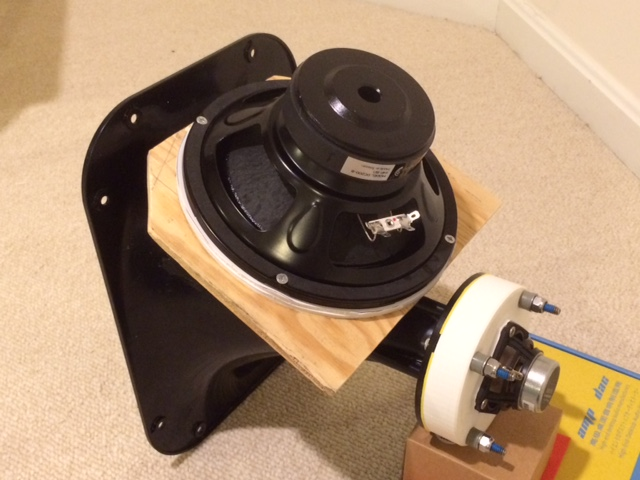
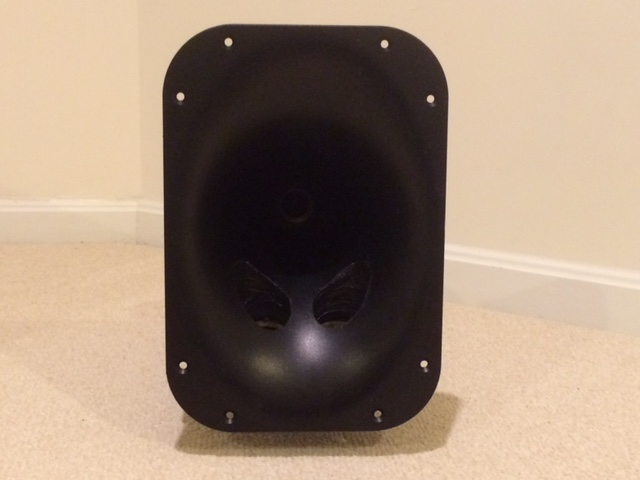
http://www.diyaudio.com/forums/multi-way/285030-bookshelf-multi-way-point-source-horn.html
Here is my build so far:


X
nice and small, I have play some with akabak, really when read it is not so difficult, yes I am 59 so my memory is not as when I was 20 years, but it works well.
I begin to get something of akabak, but have now done a part in hornresp what concerns the bass, here there is not so much problems sim it and it is more easy.
I have sim the woofer distance from throat and have two pics one for 12 cm injection port and one who is mucho smaller, it did not give much lower efficienty until you get a hug peak upwards HF. ports do so not need to be big, compression factor is the limiting factor and a huge peak as result.
Nice respons of the phillips woofers, quite sensitive.
Simming HF in hornresp is not a succes because of the exp horn.
regards.
nice and small, I have play some with akabak, really when read it is not so difficult, yes I am 59 so my memory is not as when I was 20 years, but it works well.
I begin to get something of akabak, but have now done a part in hornresp what concerns the bass, here there is not so much problems sim it and it is more easy.
I have sim the woofer distance from throat and have two pics one for 12 cm injection port and one who is mucho smaller, it did not give much lower efficienty until you get a hug peak upwards HF. ports do so not need to be big, compression factor is the limiting factor and a huge peak as result.
Nice respons of the phillips woofers, quite sensitive.
Simming HF in hornresp is not a succes because of the exp horn.
regards.
Attachments
This is with two woofers, ports are not critical except when to small then a nasty peak, see pictures of both, normal and small injection port, good is 152 cm2 and to small is 25 cm2, I think I have this devide to 4 because of 4 ports in hornresp.
regards
regards
Attachments
- Home
- Loudspeakers
- Multi-Way
- Presenting the Trynergy - a full range tractrix synergy.
